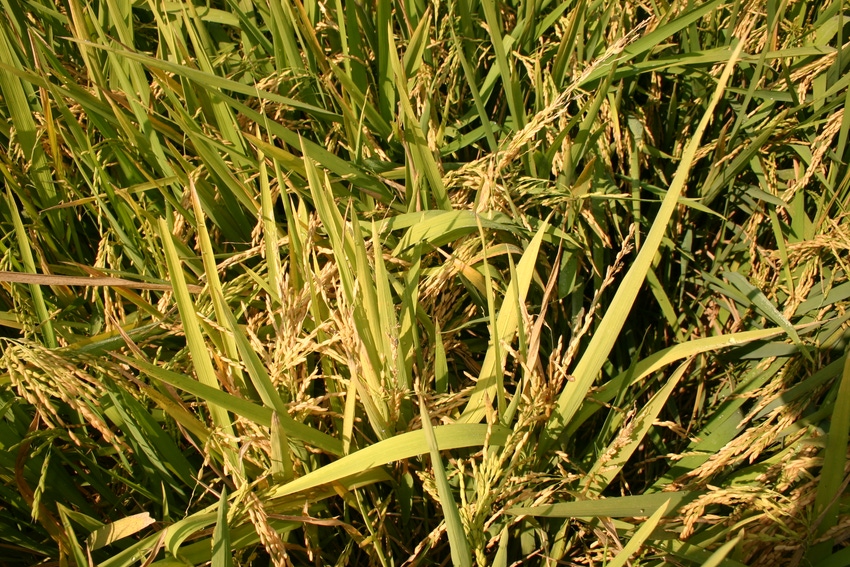
We are told history tends to repeat itself. The first winners of the Arkansas irrigation yield contest for rice, Richard and Matt Morris of Carlisle, Ark., certainly think that’s true.
“W.H. Fuller, my great uncle, got the credit for the first commercial rice crop in 1904 in the same exact field we won on,” says Richard. “Two years before that, my great-grandfather raised rice right across the road — but not on a commercial scale.”
The farmers from the community pledged to give Fuller $1,000 if he could prove rice could be grown commercially and be profitable. He made about 70 bushels to the acre and collected the $1,000.
The strange parallel between history and the present “is Matt (Richard’s son) was showing how we could raise rice with less water by using the Polypipe method in alternate wetting and drying. We got about $20,000 for winning — all merchandise, rice seed, and equipment.”
The farm was established in 1892. “We’re charter Century Farm members in the state. Matt is the fifth generation to farm it and his kids are the sixth generation coming up.”
The Morris duo farm about 1,350 acres with about 400 acres of rice. All their rice fields were treated the same way with irrigation.
2018
“Our average for 2018 was 16 acre inches applied water,” says Matt. “We had 14 inches of rain from emergence to maturity to add to that. The way the contest works is they used an app that checked rainfall for a certain location based on radar images.”
How were the Morris’ drawn to the contest?
“I believe a Delta Plastics employee came by and mentioned the contest,” says Matt. “Shortly after, we read about it.
“This is the first ‘Crop per Drop’ contest in the state. I was in contact with Chris (Henry, University of Arkansas irrigation specialist) throughout the year — not so much on the contest end but to draw on his knowledge regarding irrigation. They let us borrow equipment like surge valves we use on furrow-irrigated crops and provided flow meters for the contest. They sealed everything up and put stamps on to keep anyone from tampering.
“This fell into place with all the technology and different things we’ve begun to use. We’re trying to integrate new ideas on our farm. How we irrigate now compared to just five years ago is completely different.”
The water table in the area is dropping. “There are wells all around us going out,” says Matt. “Plus, the cost of having to run a deep well with a 200-horsepower motor is quite a bit. We have a 70-acre reservoir built in 1981 — the year after the great drought in 1980. That has held our farm, but we still have to use the deep well to put back into the reservoir.”
Through NRCS, the Morrises “have been taking advantage of the EQIP program and level fields on a slight grade. In 2016, we built a 20-acre reservoir with a tail-water ditch and have tied that to an existing underground line to give us more surface water storage. So, we’re not relying on our deep well as much.”
2018 was extremely dry for the farm, says Matt. “Even in the same county, not 10 or 15 miles over, they might have gotten 6 inches of rain and we got a quarter-inch. That really pushed us to test our water storage. It turned out we did very well and had a lot of rice.”
The set-up
“The way we water now is multiple-inlet,” says Matt. “Every field we have is multiple-inlet and we started that in 2017. Next year, we’ll plant even more rice because we found out by using things like flow meters we can dial volumes in, especially when we’re using computer programs telling us what hole sizes to punch and the amount to put in the line to make everything work properly. That’s very efficient and we have to do that to protect our groundwater because it’s a finite resource.”
The father and son team use the alternate water and drying method — intermittent watering. “So, you have Polypipe in the rice and in most fields I can have the ground covered in three days, four days at most,” says Matt. “Then, you hold the flood for 21 days. After that, you can begin the alternate wetting and drying.
“You use water column pipes that have holes drilled in the side that go in the ground. They’re probably a foot tall and we put them in the ground 6 inches. When you let the water drop, it will go lower than the surface level. But you can walk to the pipe and look into it and see water is right below the surface. Then, since we’re using multiple-inlet, we turn the pump back on and let it run. Obviously, you don’t want to let the ground get very dry.”
For the contest field, Matt “tried to hold a 2-inch floor, or less. Generally, though, I try to hold a 3- or 4-inch flood. Once the field fills up, you turn the pump back off and let the water level go back down again as the plants grow.”
Note: the Morris’ water use efficiency was 7.80 bushels per acre-inch. They planned their Multiple Inlet Rice Irrigation using the UA “Rice Irrigation” mobile app, a Davis Enviromonitor Weather Station, an Unmanned Aerial Vehicle, surface water reservoirs and tailwater recovery, alternate wetting and drying as well as N ST*R nutrient management to achieve their high irrigation efficiency and yields. Their rice yielded 229 bushels per acre using Ricetec 7311.
About the Author(s)
You May Also Like




